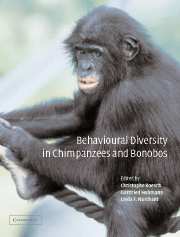Book contents
- Frontmatter
- Contents
- List of contributors
- Preface
- Behavioural Diversity in Pan
- PART I BEHAVIOURAL FLEXIBILITY
- PART II SOCIAL RELATIONS
- INTRODUCTION
- 6 Factors influencing fission–fusion grouping in chimpanzees in the Taï National Park, Côte d'Ivoire
- 7 Ecological and social correlates of chimpanzee party size and composition
- 8 Agonistic relations among Kanyawara chimpanzees
- 9 Relationships of male chimpanzees in the Budongo Forest, Uganda
- 10 Dynamics in social organization of bonobos (Pan paniscus)
- PART III FEMALE STRATEGIES
- PART IV HUNTING AND FOOD SHARING
- PART V GENETIC DIVERSITY
- Index
7 - Ecological and social correlates of chimpanzee party size and composition
Published online by Cambridge University Press: 08 February 2010
- Frontmatter
- Contents
- List of contributors
- Preface
- Behavioural Diversity in Pan
- PART I BEHAVIOURAL FLEXIBILITY
- PART II SOCIAL RELATIONS
- INTRODUCTION
- 6 Factors influencing fission–fusion grouping in chimpanzees in the Taï National Park, Côte d'Ivoire
- 7 Ecological and social correlates of chimpanzee party size and composition
- 8 Agonistic relations among Kanyawara chimpanzees
- 9 Relationships of male chimpanzees in the Budongo Forest, Uganda
- 10 Dynamics in social organization of bonobos (Pan paniscus)
- PART III FEMALE STRATEGIES
- PART IV HUNTING AND FOOD SHARING
- PART V GENETIC DIVERSITY
- Index
Summary
INTRODUCTION
Why primates live in social groups and what factors account for variation in group size and composition have been two central questions in the study of primate behavioral ecology (Alexander 1974; Altmann 1974; Wrangham 1980; van Schaik 1983; Rodman 1988; Isbell 1994; Janson & Goldsmith 1995). Theory suggests that the relative costs and benefits of grouping will influence variations in group size and composition. Several factors, such as feeding competition, predation risk, and competition for mates, affect these costs and benefits for group members, but not necessarily equally (ibid.). For example, food generally limits female reproduction in most mammals (Trivers 1972; Bradbury & Vehrencamp 1977; Emlen & Oring 1977; Wrangham 1980; Clutton-Brock 1989), and feeding competition consequently affects females to a greater extent than males. Alternatively, females are the limiting source for reproduction by males (ibid.), and the availability of mates accordingly influences male behavior more than that of females.
The fission–fusion social system of chimpanzees provides a model system for investigating sources of variation in group size. Wild chimpanzees live in large, fluid unit-groups or communities, whose members form temporary parties that vary in size and composition (Nishida 1968; Sugiyama 1968; Halperin 1979; Boesch 1996). In keeping with predictions stemming from current theory, the availability of both food and estrous females have been implicated as important determinants of chimpanzee party size (Riss & Busse 1977; Wrangham & Smuts 1980; Ghiglieri 1984; Goodall 1986; Isabirye-Basuta 1988; Sakura 1994; Stanford et al. 1994; Chapman et al. 1995; Boesch 1996; Doran 1997; Matsumoto-Oda et al. 1998; Boesch & Boesch 2000; Wrangham 2000).
- Type
- Chapter
- Information
- Behavioural Diversity in Chimpanzees and Bonobos , pp. 102 - 111Publisher: Cambridge University PressPrint publication year: 2002
- 85
- Cited by

